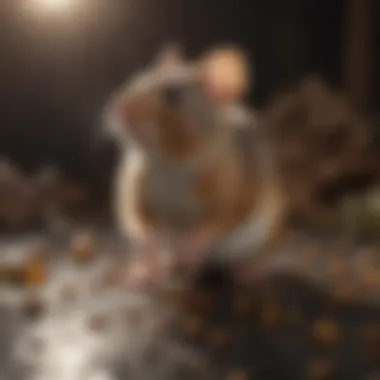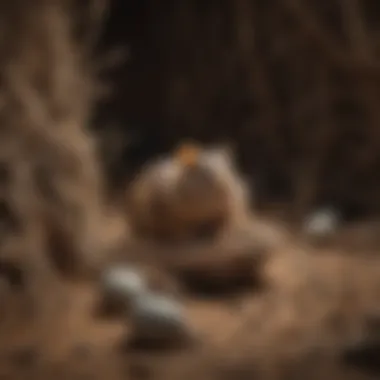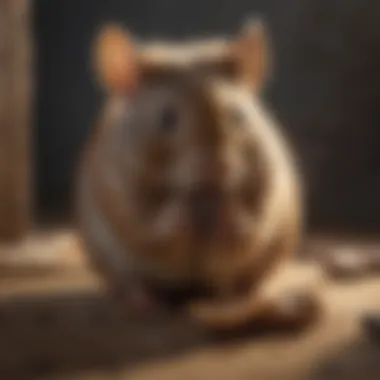Essential Rodent Inspection Checklist for a Pest-Free Environment


Preventive Pest Control Strategies
When it comes to maintaining a pest-free environment, implementing preventive pest control strategies is paramount. One of the essential aspects of this is safeguarding the house exterior. Start by inspecting and sealing any cracks or gaps that may serve as entry points for pests. Additionally, clearing debris around the exterior of the house helps eliminate potential hiding spots for rodents and insects. By taking these proactive measures, you create a barrier against pests from entering your living space.
In conjunction with house exterior protection, yard maintenance plays a crucial role in pest prevention. Engage in essential yard care routines such as regular mowing, trimming, and removing standing water to deter pests from flourishing in outdoor spaces. Implementing methods like proper waste disposal, minimizing standing water, and keeping vegetation trimmed can significantly reduce pest attraction to your yard.
Maintaining indoor cleanliness is another key factor in preventing pest infestations. Incorporate expert cleaning tips and techniques that focus on areas prone to pests, such as kitchens and storage spaces. By consistently keeping indoor areas clutter-free, well-ventilated, and dry, you create a hostile environment for unwanted intruders.
Proper garbage disposal is often underestimated but plays a significant role in pest control. Efficient waste disposal methods not only help in preventing pest infestations but also contribute to maintaining overall hygiene. Emphasize the importance of securing trash bags, using sealed bins, and keeping garbage areas clean to minimize pest attraction.
To complement these preventive strategies, explore other innovative ways to safeguard your home from pests. This could involve utilizing natural repellents, creating barriers, or exploring eco-friendly pest control solutions. By integrating various techniques, you establish a robust defense system against potential pest threats.
Introduction
Understanding the Importance of Rodent Inspection
Overview of Rodent Infestation Risks
Delving into the realm of rodent infestation risks is crucial for understanding the potential threats these pests pose. From structural damage to health hazards, rodents can wreak havoc in residential settings. By comprehensively exploring the risks associated with rodent infestations, individuals gain a deeper insight into why proactive inspection measures are essential. This section highlights the prevalence of rodent-related issues, emphasizing the importance of early detection and intervention to prevent severe consequences.
Impact on Health and Property
The impact of rodent infestations on health and property cannot be overstated. Not only do rodents carry diseases that can be transmitted to humans, but they also pose a threat to the structural integrity of buildings. Health risks include allergic reactions, respiratory ailments, and exposure to harmful pathogens carried by rodents. Additionally, property damage caused by gnawing and nesting behaviors can result in costly repairs. Understanding these implications underscores the urgent need for diligent rodent inspection and control measures.
Purpose of the Checklist
Preventive Measures


Employing preventive measures is a cornerstone of effective rodent control. By implementing strategies such as sealing entry points, minimizing food sources, and maintaining cleanliness, individuals can create an inhospitable environment for rodents. Preventive measures aim to disrupt the rodents' access and attraction to properties, thus reducing the likelihood of infestations. This section outlines proactive steps that individuals can take to fortify their homes against potential rodent invasions.
Early Detection of Infestations
Early detection is key to preventing the escalation of rodent infestations. By spotting signs of rodent activity promptly, individuals can take swift action to address the issue before it spirals out of control. This aspect of the checklist focuses on recognizing indicators of rodent presence, such as droppings, gnaw marks, and nesting materials. Through vigilant monitoring and timely intervention, homeowners can nip potential infestations in the bud, safeguarding their properties and well-being.
Exterior Inspection
In the realm of pest control, exterior inspection holds paramount importance as it serves as the initial line of defense against rodents infiltrating a property. This section of the comprehensive checklist delves into scrutinizing the outer perimeter and outdoor areas to identify vulnerabilities where rodents might gain access. By focusing on the external spaces surrounding a premise, homeowners can proactively mitigate the risks of infestations.
Perimeter Check
Entry Points Evaluation
Entry points evaluation within the perimeter check involves a detailed assessment of any potential openings that rodents could utilize to enter a structure. These could range from cracks in the walls to gaps in doors or windows. The key characteristic of this evaluation is its thoroughness in identifying even the smallest of openings, highlighting its crucial role in preventing rodent intrusion effectively. One unique feature of entry points evaluation is its proactive nature, allowing homeowners to address vulnerabilities before they result in a full-blown infestation. While time-consuming, this exercise reaps immense benefits for maintaining a pest-free environment.
Vegetation Management
Vegetation management plays a pivotal role in exterior inspection by focusing on the outdoor areas surrounding a property. Maintaining proper landscaping practices can deter rodents attracted to overgrown vegetation, which provides hiding spots and easy access to buildings. The key characteristic of this aspect is the strategic trimming and upkeep of plants to minimize potential hiding spots for rodents. Effective vegetation management acts as a preventative measure, reducing the likelihood of rodent activity near the property. While it requires regular maintenance, the advantage lies in creating a less appealing environment for rodents, thereby decreasing the risk of infestation.
Outdoor Areas Assessment
Garbage Disposal
The inspection of garbage disposal areas is crucial in mitigating the risk of rodent infestations. Proper waste management practices prevent rodents from accessing a food source and nesting in outdoor bins. Emphasizing clean and secure waste disposal facilities is the key characteristic of this assessment, as it eliminates attractants for rodents. One unique feature of garbage disposal evaluation is its direct impact on reducing rodent activity, ultimately contributing to a pest-free environment. While it demands vigilance and regular cleaning, the advantage lies in maintaining a hygienic outdoor space that deters rodents.
Structural Integrity Review
Assessing the structural integrity of outdoor areas is essential in preventing rodent access to a property. This review entails inspecting for any damages or weaknesses in the building's exterior that could serve as entry points for rodents. The key characteristic of this review is ensuring that the premises are secure and rodent-proof, minimizing opportunities for infiltration. A unique feature of this assessment is its focus on long-term protection, as maintaining structural integrity reduces the need for frequent repairs due to rodent damage. While it requires thorough examination and potential repairs, the advantage lies in fortifying the property against rodent incursions, ensuring a pest-free environment.


Interior Inspection
Interior inspection is a crucial step in the rodent inspection checklist as it focuses on assessing potential rodent entry points and habitats within the confines of the property. By meticulously examining the interior spaces, homeowners can proactively identify and address any signs of rodent activity, mitigating the risk of infestations spreading throughout the house. This section delves into key aspects such as kitchen, pantry, living areas, attic, basement, and storage spaces, offering a comprehensive evaluation of the property's vulnerability to rodent intrusion.
Kitchen and Pantry
The kitchen and pantry represent prime areas for rodents to find food sources, making them crucial inspection points for rodent control. The [Food Storage Examination] aspect involves scrutinizing how food items are stored, ensuring they are sealed in airtight containers to prevent access by rodents. This meticulous examination leads to early detection of any signs of food tampering or contamination, aiding in safeguarding the household against health risks associated with rodent presence. Implementing a structured food storage examination routine is imperative in maintaining a pest-free environment, reducing the likelihood of attracting rodents with accessible food sources.
The [Appliance Inspection] aspect focuses on checking for any openings or gaps around appliances that could serve as entry points for rodents. By ensuring appliances are properly sealed and maintained, homeowners can fortify their defenses against rodent infiltration. This in-depth inspection not only enhances the property's security against pests but also prolongs the lifespan and efficiency of the appliances, contributing to overall home maintenance.
Living Areas
The living areas of a home provide ample opportunities for rodents to hide and nest, necessitating detailed inspection and vigilance. The [Furniture Check] aspect entails examining furniture for any signs of gnawing, nesting materials, or droppings that indicate rodent presence. By maintaining furniture in a well-maintained condition and promptly addressing any signs of infestation, homeowners can minimize the risk of rodents establishing territories within the living spaces.
Moreover, [Clutter Management] plays a significant role in rodent prevention by reducing potential hiding spots and nesting areas for rodents. By decluttering and organizing living spaces, homeowners can effectively disrupt the habitat preferences of rodents, making the environment less hospitable for infestations. Implementing clutter management strategies not only improves the aesthetics and functionality of living areas but also enhances the overall cleanliness and hygiene standards of the home.
Attic and Basement Review
In the realm of rodent inspections, the Attic and Basement Review represent crucial areas for assessment. These spaces often serve as prime locations for potential rodent infestations due to their secluded nature and ample nesting opportunities. Inspecting the attic and basement is essential in safeguarding your property against rodent intrusions and maintaining a pest-free environment.
Insulation Inspection
Signs of Nesting
The Signs of Nesting within these enclosed spaces offer valuable insights into potential rodent activities. Detecting signs such as shredded paper, fabric scraps, or gnawed materials can indicate the presence of rodents seeking shelter and breeding grounds. Recognizing these indications early on is paramount in preventing full-blown infestations and addressing rodent issues promptly. Signs of Nesting serve as a key identifier for rodent presence, alarming homeowners to take necessary actions to eradicate these pests and fortify their property's defenses against unwelcome invaders. While unsettling, understanding and identifying Signs of Nesting play a vital role in the comprehensive rodent inspection checklist, ensuring thorough scrutiny and proactive measures to maintain a pest-free environment.
Ventilation Analysis


Conducting a Ventilation Analysis in the attic and basement is integral to assessing the airflow and environment conducive to rodent habitation. Proper ventilation not only regulates temperature and humidity levels but also discourages rodents from settling in these spaces. By evaluating the ventilation systems, homeowners can identify potential entry points for rodents and implement necessary interventions to enhance airflow and minimize rodent accessibility. A well-ventilated attic and basement create inhospitable conditions for rodents, reducing the likelihood of infestations and fostering a healthier living environment. Integrating Ventilation Analysis into the rodent inspection checklist ensures comprehensive scrutiny of all factors contributing to rodent attraction and survival, emphasizing the importance of proper airflow management in mitigating pest risks.
Storage Areas Evaluation
Organization Assessment
The Organization Assessment within storage areas plays a critical role in rodent prevention strategies. Maintaining a well-organized storage space minimizes potential hiding spots for rodents and enhances visibility for early detection of any rodent activities. Evaluating the organization of storage areas allows homeowners to declutter, remove unnecessary items, and seal off potential entry points, creating a less attractive environment for rodents seeking shelter and resources. A systematic and orderly approach to storage not only promotes cleanliness but also facilitates routine inspections and pest control measures. Incorporating Organization Assessment into the rodent inspection checklist underscores the significance of organization in deterring rodent infestations and optimizing storage space for pest-free living.
Sealing Gaps
Sealing Gaps within storage areas serves as a preventive measure against rodent entry and infestation. Rodents can exploit even the smallest openings to gain access to storage spaces, posing a threat to property integrity and hygiene. Identifying and sealing gaps with appropriate materials such as caulk, steel wool, or weather stripping effectively block rodent pathways and limit their potential entry points. By addressing gaps in walls, floors, and ceilings, homeowners can fortify their storage areas against rodent intrusion and safeguard valuable belongings from damage or contamination. The act of Sealing Gaps is a proactive step towards rodent-proofing storage areas, preventing infestations, and maintaining a pest-free environment for long-term peace of mind.
Professional Consultation and Follow-Up
In the realm of pest control management, professional consultation and follow-up play a pivotal role in ensuring the effectiveness and longevity of rodent inspection efforts. This article emphasizes the critical nature of seeking expert guidance and the benefits it offers in maintaining a pest-free environment. Professional consultation provides a wealth of knowledge and experience that can help homeowners make informed decisions regarding rodent control strategies. By collaborating with pest control specialists, individuals can gain insights into the specific rodent threats facing their property and tailor preventive measures accordingly. Moreover, follow-up services ensure that the implemented solutions are monitored and adjusted as needed to address any emerging issues promptly.
Choosing Pest Control Services
Credentials Verification
Credentials verification stands as a cornerstone in the process of selecting pest control services. By verifying the credentials of a pest control company, homeowners can ensure that they are entrusting their property to qualified and reputable professionals. The key characteristic of credentials verification lies in validating the legitimacy and expertise of the pest control provider. This meticulous process safeguards against potential scams or subpar service, giving homeowners peace of mind in their pest control choices. Additionally, the unique feature of credentials verification lies in its ability to guarantee that the selected pest control service adheres to industry standards and best practices, thereby enhancing the efficacy of rodent inspection and control efforts.
Service Plans Comparison
When considering pest control services, conducting a thorough comparison of service plans is paramount in aligning the chosen provider with the specific needs outlined in this article. Service plans comparison allows homeowners to evaluate the scope of services offered, pricing structures, and included guarantees. The key characteristic of service plans comparison lies in facilitating an informed decision-making process by highlighting the differences and similarities between various pest control packages. By identifying the most suitable service plan based on individual requirements, homeowners can optimize their investment in rodent inspection and control. Furthermore, the unique feature of service plans comparison enables homeowners to select a provider that offers tailored solutions, thus maximizing the long-term effectiveness of pest management strategies.
Monitoring and Maintenance
Regular Inspections
Regular inspections form the foundation of a proactive pest management approach, contributing significantly to the overall goal of maintaining a pest-free environment. The key characteristic of regular inspections lies in their systematic nature, allowing for the early detection of potential rodent infestations. By scheduling routine inspections, homeowners can identify and address rodent entry points, nesting sites, and other risk factors promptly. This proactive measure mitigates the likelihood of extensive infestations and minimizes property damage. Additionally, the unique feature of regular inspections lies in their ability to provide continuous monitoring of pest activity, enabling swift intervention when signs of infestation are observed.
Preventive Strategies
Incorporating preventive strategies into the maintenance routine is crucial for reinforcing the effectiveness of rodent inspection and control measures outlined in this article. Preventive strategies encompass a range of practices designed to deter rodents from invading the property and creating conducive environments for infestation. The key characteristic of preventive strategies lies in their proactive nature, aiming to disrupt the typical behaviors and habits of rodents through strategic interventions. By implementing measures such as sealing entry points, eliminating food sources, and maintaining proper sanitation, homeowners can reduce the risk of recurrent infestations significantly. Moreover, the unique feature of preventive strategies lies in their long-term impact, establishing a stronghold against future rodent incursions and preserving a pest-free environment.



